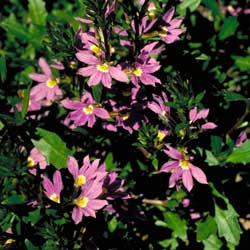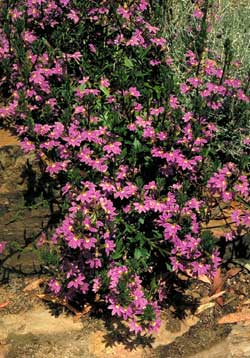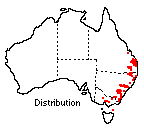Scaevola aemula
 |
 |
Fairy Fan-flower
Scaevola aemula is a member of the family Goodenaceae. The widely known common name is Fairy Fan-flower, which pertains to the small size of the S. aemula plants.
 It
is distributed along the New South Wales and Victorian coastlines where it can
be found in the form of a low growing perennial herb.
It
is distributed along the New South Wales and Victorian coastlines where it can
be found in the form of a low growing perennial herb.
The plant may be either decumbent or ascending in growth with a height up to 60 cm tall. Hairs are present on the on the stems, flowers and fruits of the plant. On the stems the hairs are course and yellow in colour. The floral hairs are present on the inside and outside. The outer hairs are course and dense and the inner hairs are simple and give a bearded look to the inside of the flower.
The flowers have a beautiful fan shape with the typical colouration of purple, blue or mauve. This petal colour is combined with a white or more commonly a yellow centre to give a bright eye catching flower. The flowers grow at various points along the stems and they decrease in size from the top to the bottom of the plant. From spring through to the end of summer these flowers can be admired. This blooming time alters according to the length of summer and the temperatures of the season.
Although this plant is plant is not currently widely cultivated, it's fast growth rate and prolific flowering should soon change this. S. aemula is extremely versatile and is recommended for growing in pots as well as garden beds. It also is good for attracting birds and insects. The more decumbent forms of S. aemula have great potential as ground covers.
Seeds or cuttings can be used to propagate this plant. The seeds need to be sown fresh and the cutting need to be semi-ripe. The cuttings need to be placed in a sand-filled container and kept at warm temperatures. These plants are frost sensitive and do not do well in colder areas. S. aemula also requires well-drained sandy soil and a good sunny position.
S. aemula would make a great addition to any coastal garden or indoor area.
The plant illustrated on this page is sold as Scaevola aemula 'New Blue', one of the many cultivars.
Text by Ngaire Nunn (2002 Student Botanical Intern)
Name meaning: Scaevola aemulaScaevola - from the Latin scaevus, which means left-handed. This refers to the one-sided feature of the fan shaped corolla. aemula - striving to, emulating, rivaling. |
References:
Greig, D. Colour Guide to the Wildflowers of Eastern Australia.
Wrigley, J.W. & Fagg, M. Australian Native Plants: Fourth Edition.
![An Australian Government Initiative [logo]](/images/austgovt_brown_90px.gif)

